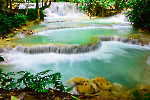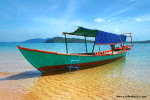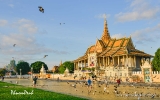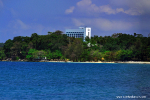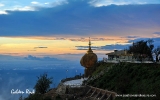The name Siem Reap literally means "Siam Defeated". This once quaint village has become the largest boom town and construction site in Cambodia. Siem Reap has colonial and Chinese-style architecture in the Old French Quarter, and around the Old Market. In the city, there are traditional Apsara dance performances, craft shops, silk farms, rice-paddy countryside, fishing villages and a bird sanctuary near the Tonle Sap Lake.
Today, Siem Reap serves as a small gateway town to the world famous heritage site of the Angkor temples. Thanks to those attractions, Siem Reap has transformed itself into a major tourist hub. Siem Reap nowadays is a vibrant town with modern hotels and architectures. Despite international influences, Siem Reap and its people have conserved much of the town's image, culture and traditions.
Geography:
Siem Reap province is 10,299 square kilometres big. It's located in the Northwest of the country bordering to the North with Oddor Meanchey, to the East with Preah Vihear and Kampong Thom, to the West with Banteay Meanchey and to the South with the biggest sweet water reserve in Southeast Asia, the huge Tonle Sap Lake.
Climate:
Siem Reap features a tropical wet and dry climate. The city is generally hot throughout the course of the year, with average high temperatures around 30 C in any month. Siem Reap has a relatively lengthy wet season which starts in April and ends in November. The dry season covers the remaining four months. The city averages approximately 1500 mm of rainfall per year.
Note:
- The best time to visit Siem Reap is from November to March when the weather is cooler and dry.
- Credit card (Visa card / Master card…) are very common. Most of the hotels, restaurants, shops in big cities accept it. And you can withdraw cash from ATM machines in Siem Reap.
Besides local currencies, US dollars is used everywhere, you don’t need to change USD to Riel. 1 USD ~ 4000 Riel (Cambodian currency)
- Appropriate attire when visiting temples/pagodas is long pants (covering the knee) and shirts that cover shoulders. Skirts, small shorts, tank tops, and other items of revealing clothing are not allowed within temple grounds (Angkor Temples). Visitors can and are frequently turned away from temples when wearing revealing clothing.
- Entrance fee to Angkor Complex: 20USD/ person for 1 day visit; 40USD/ person for 2-3days visit; 60USD/ person for 4-6days visit
Opening time: from 5am to 5pm every day.
Highlights:
Traveling to Siem Reap, you should spend 4-5 nights here to visit all famous places.
Known as the symbol of Cambodia, Angkor Wat and other temples in Angkor Archaeological Park are the must-see places when you visiting Cambodia. You will need a week or more to discover all ruin temples in the area of over 400 kilometers square. However, with 2 to 3 days visit this area is enough for you to explore the most beautiful temples: Angkor Wat, Angkor Thom, Banteay Srei, etc.
Besides Amazing Angkor temples, Tonle Sap Lake is a break from visiting temples This is the largest permanent fresh-water lake in South Asia and flows into Tonle Sap River, joining the Mekong in Phnom Penh. We will see a “floating village” – boats have been converted to look like houses and the “village” move from place to place following water levels.
For adventurous travelers, Kulen Moutain is the ideal place for trekking and immersing yourself in the nature. Kulen Waterfall, River of a Thousand Lingas, Preah Ang Thom, etc. are the attractions you will drop in when traveling to this Holy Mountain.
Siem Reap is also known with many special activities you should try, such as horse cart riding, Jeep Tour, Gibbon Quad Adventure, Balloon Ride over Angkor Wat, Elephant riding around Bayon temple and Cooking Class.

